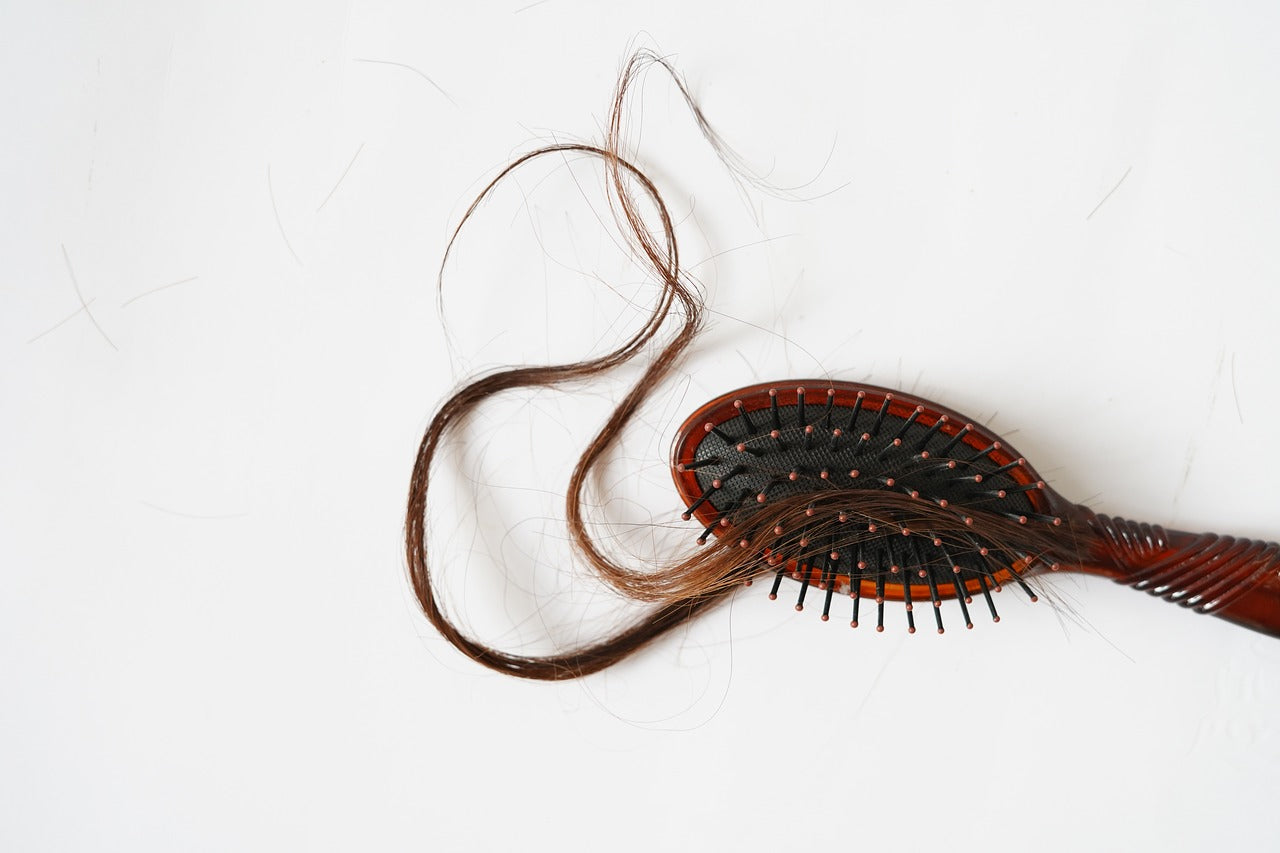Hair loss, or alopecia can be tough for many women. It is a common experience for about one-third of women at some point in their lives. Among postmenopausal women, as many as two-thirds may encounter hair thinning or develop bald spots.
In healthy women, around 6% to 38% may experience some degree of frontal and/or frontal-parietal hair loss (Birch et al., 2001). Unlike men, female pattern hair loss (FPHL) typically begins during the reproductive years.
Now, a solution to this problem is Pyrilutamide that people are looking at for help. In this blog, we will try to understand understand the ins and outs of female hair loss. We'll also talk about Pyrilutamide such as what it is and how it could be a potential solution for women's hair loss.

What is Pyrilutamide?
Pyrilutamide, also known as KX-826, is a topical drug developed by Kintor Pharmaceutical Limited. It functions as an androgen receptor-blocking medication and is being investigated for the treatment of pattern hair loss, specifically androgenetic alopecia.
Pyrilutamide has successfully completed phase II clinical trials in men and is currently undergoing clinical trials for both men and women in China, as well as men in the United States.
In addition to its potential application for hair loss, Kintor is exploring the use of pyrilutamide as a treatment for acne vulgaris. While the acne treatment is still in the preclinical stage in the United States, it has already entered phase II clinical trials in China.
The development of pyrilutamide for the treatment of pattern hair loss, or androgenetic alopecia, is an ongoing process with clinical trials aimed at establishing its efficacy and safety. If proven successful, these trials may pave the way for increased accessibility and potential FDA approval.
As of today, the available treatments for improving hair thickness and growth in androgenetic alopecia patients are somewhat limited. The only FDA-approved drugs for male androgenetic alopecia are topical minoxidil and oral finasteride. For female pattern hair loss, only topical minoxidil is FDA-approved. However, both of these drugs come with certain limitations and side effects. While hair transplantation is effective, it is often expensive.
In addition to pyrilutamide, another topical androgen receptor inhibitor undergoing clinical trials for hair loss is clascoterone 7.5% solution, known as Breezula. The outcomes of these trials may contribute to expanding the available options for individuals dealing with androgenetic alopecia.
How Does Pyrilutamide Work?
Pyrilutamide works as an androgen receptor antagonist and blocks dihydrotestosterone (DHT) from binding to receptors in hair follicles. This action prevents the effects of androgens on the hair follicle, specifically miniaturization and eventual hair loss.
In contrast to commonly used 5-alpha reductase inhibitors like finasteride and dutasteride, which inhibit the conversion of testosterone to DHT, pyrilutamide is a topical anti-androgen. Clinical trials indicate that it does not decrease systemic androgen levels, making it less likely to cause the unwanted adverse reactions often associated with oral 5-alpha reductase inhibitors, such as decreased libido, erectile dysfunction, and depression.
While these observations are based on the company's clinical trials, further research will be essential to comprehensively understand pyrilutamide's safety and efficacy profile, including comparisons with topical finasteride. With its unique mechanism of action and safety profile, topical pyrilutamide holds the potential to become another FDA-approved drug.
Female Hair Loss: Causes
Hair loss in women can be attributed to a multitude of factors, such as:
Hormonal Changes:
Fluctuations in hormones, particularly during pregnancy, childbirth, and menopause cause hair loss. An imbalance in androgens, the male hormones present in both men and women, can lead to a condition known as androgenetic alopecia, a common cause of hair thinning.
Genetics:
Hereditary factors are also determinants in female hair loss. If there is a family history of hair loss, especially in female relatives, it increases the likelihood of experiencing similar issues.
Lifestyle Factors:
Poor nutrition, extreme dieting, and certain lifestyle choices, such as excessive heat styling or harsh chemical treatments, can contribute to weakened hair shafts and increased hair shedding.
Medical Conditions:
Underlying medical conditions like thyroid disorders, autoimmune diseases, and certain skin conditions may also manifest in hair loss.
Beyond the physical aspects, female hair loss often exacts a profound emotional toll. Society's beauty standards and cultural expectations can exacerbate the distress caused by losing one's hair.

Existing Treatments for Female Hair Loss
Here's an overview of the existing treatments and their potential impact:
Topical Solutions
Minoxidil:
- Widely used and FDA-approved, minoxidil is a topical solution applied directly to the scalp. It's believed to increase blood flow to the hair follicles, promoting hair growth.
- Effectiveness varies among individuals, and continuous use is often required. Some users may experience scalp irritation as a side effect.
Topical Corticosteroids:
- Prescribed for certain types of hair loss, corticosteroids reduce inflammation and can be applied topically or injected into the scalp.
- Long-term use may lead to side effects such as thinning of the skin or the development of small blood vessels.
Medications
Antiandrogens:
- Medications like spironolactone or cyproterone acetate may be prescribed to counteract the effects of androgens, particularly in cases of androgenetic alopecia.
- Side effects may include menstrual irregularities, breast tenderness, or potassium level changes.
Finasteride:
- While more commonly prescribed for men, some women may use finasteride off-label. It works by inhibiting the action of the hormone dihydrotestosterone (DHT).
- Side effects may include sexual dysfunction, and it is not recommended for pregnant women due to the risk of birth defects.
Lifestyle Changes
Diet and Nutrition:
- Ensuring a balanced diet with essential nutrients like iron, zinc, and vitamins is crucial for maintaining healthy hair.
- Dietary supplements may be recommended in cases of nutritional deficiencies.
Avoidance of Harsh Hair Practices:
- Minimizing heat styling, chemical treatments, and tight hairstyles can prevent further damage to fragile hair.
While these treatments are known for positive results for some, individual responses vary. What works for one person may not work for another, and side effects can occur. Additionally, consistency and patience are often required, as results may take several months to become noticeable.

Pyrilutamide for Hair Loss
Recent clinical trials exploring the use of Pyrilutamide for hair loss, particularly in cases of androgenetic alopecia, have shown promising results. Here's an overview of the key findings from the conducted trials:
Phase-1 Clinical Trial
A randomized, double-blind, placebo-controlled phase-1 clinical trial involving 40 healthy adult male patients with androgenetic alopecia was conducted in the US. The trial aimed to assess the safety, tolerability, and pharmacokinetics of topical Pyrilutamide at different dose levels (3mg, 12mg, 48mg, and 96mg). The results indicated that the blood concentration of Pyrilutamide remained low, and no severe adverse drug events were reported, suggesting good safety parameters.
Phase-2 Clinical Trials in China
The first phase-2 clinical trial, a multi-regional randomized placebo-controlled study conducted in China, involved 120 subjects with male androgenetic alopecia. Participants were divided into four dose groups, with the 0.5% Pyrilutamide solution applied twice a day showing statistically significant improvement in total area hair count after six months of treatment. These positive results led to the selection of the 0.5% Pyrilutamide solution for the subsequent phase-3 clinical trial.
Phase-2 Clinical Trial in the USA
A randomized, double-blind, placebo-controlled phase-2 trial in the USA enrolled 123 patients for the treatment of male pattern alopecia. Different dosage groups, including 0.25% once daily, 0.5% once daily, and 0.5% twice daily, were assessed. The study reported a substantial increase in the target area hair count by approximately 10 hairs per cm2 from baseline after 24 weeks of treatment with the 0.5% twice-daily regimen. The results were deemed statistically and clinically meaningful.
Female Pattern Hair Loss Study
As of now, Kintor is conducting clinical trials for female androgenetic alopecia in China. In March 2022, the company announced the completion of patient enrollment (160 women) for the phase II clinical trial of KX-826. Subsequently, in December 2022, they reported the successful completion of the clinical trial.
The phase II trial was a 24-week, multicenter, randomized, double-blind, placebo-controlled study that included four treatment groups and two control groups. All women enrolled had moderate to severe symptoms of female pattern hair loss, classified as grade D3, D4, D5, or D6 on the Savin Density Scale.
The four treatment groups assessed in the trial included different concentrations and application frequencies of pyrilutamide:
- Pyrilutamide 2.5 milligrams (0.25% concentration) applied once daily
- Pyrilutamide 2.5 milligrams (0.25% concentration) applied twice daily
- Pyrilutamide 5 milligrams (0.5% concentration) applied once daily
- Pyrilutamide 5 milligrams (0.5% concentration) applied twice daily
The study reported that applying 0.5% pyrilutamide once a day resulted in the most significant improvements in hair growth, increasing hair count by 11.39 hairs per cm² from baseline after 24 weeks of treatment. Notably, improvements in hair regrowth were noticeable by week 12, and the results were considered statistically significant. No serious adverse events were reported during the trial.
Based on these findings, Kintor plans to proceed with phase III clinical trials, focusing on the once-a-day 0.5% dose of KX-826 for women with pattern hair loss. It is not clear whether the ongoing phase III safety study, enrolling female participants, is assessing this specific dose of KX-826. Source
Pyrilutamide Side Effects
The most recent clinical trial results for Pyrilutamide provide encouraging insights into the compound's safety profile. The trials affirm the absence of serious adverse reactions with the positive safety outcomes observed in earlier Phase I/Ib trials.
Mild and Limited Side Effects:
Users in the clinical trials reported only mild side effects such as itchy, dry skin, redness, irritation, and contact dermatitis. These effects are relatively common with topical medications and, in the case of Pyrilutamide, seem to be manageable.
Consistency with Previous Trial Results:
The continuity of these safety results with those from the Phase I/Ib clinical trials is noteworthy. In both instances, side effects were predominantly related to contact dermatitis. However, it remains uncertain whether this effect is attributed to the drug itself or the solution used for drug delivery, a common challenge seen in other topical medications such as liquid minoxidil.
Androgen Receptor Blocker with Limited Systemic Impact:
As an androgen receptor blocker, Pyrilutamide theoretically possesses the potential for serious side effects akin to those associated with oral finasteride and oral dutasteride.
However, the Phase II clinical trial for Pyrilutamide demonstrated that the daily repeated application of the topical medication did not lead to the same build-up of the drug in the bloodstream.
Reduced Risk of Systemic Side Effects:
Unlike oral medications where the drug can accumulate in the bloodstream, the topical application of Pyrilutamide appears to mitigate the risk of similar systemic side effects. This finding is particularly reassuring for individuals considering long-term use of Pyrilutamide for hair loss treatment.
Conclusion
In conclusion, Pyrilutamide seems like a hopeful option for women dealing with hair loss. The results from recent trials show that it could be effective in making hair grow better, and it doesn't seem to cause big problems. People in the trials mostly just had minor issues like itchy or dry skin.
What's also good is that it doesn't seem to build up in the body like some other medicines that might cause stronger side effects. Still, it's important to be careful and talk to a doctor before trying Pyrilutamide for hair loss. The bigger study they're doing now will give us more details about how well it works and if it's safe for the long run.
You can get authentic Pyrilutamide solution from MV Supplements Europe. Our commitment to transparency and customer safety is paramount and we strongly encourage individuals to consider lab testing our product for their peace of mind. We believe in providing our customers with the highest quality, and we are confident that our Pyrilutamide meets rigorous standards.
If you're looking for a reliable source for Pyrilutamide and value authenticity, MV Supplement Europe is here to meet your needs. Please consult with a healthcare professional before considering any new supplement. Your health and satisfaction are our top priorities.




Leave a comment
This site is protected by hCaptcha and the hCaptcha Privacy Policy and Terms of Service apply.